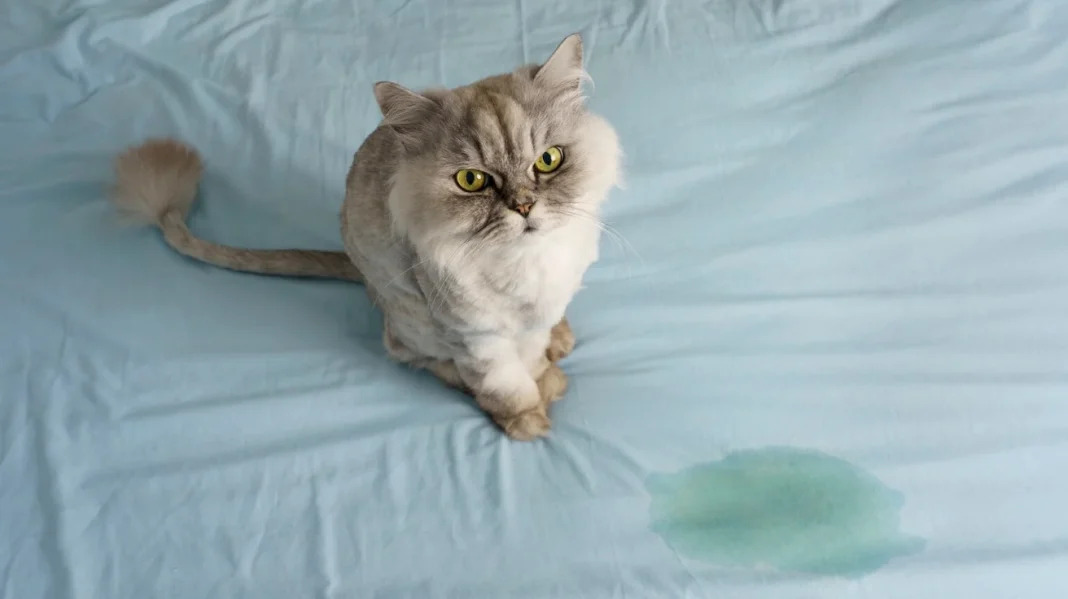Ugh, that moment. You’re looking forward to a comfy bed, or maybe you’ve just opened your eyes in the morning, and then you see it – that damp patch. And your nose confirms, it’s definitely not spilled tea. Your cat has decided your bed is the new litter box. If this is your current reality, please, please know you’re not the only one who’s ever dealt with this, and as absolutely maddening and, let’s be honest, downright gross as it is, your cat isn’t plotting revenge for that cheap brand of cat food you bought last week.
When a cat starts peeing where they shouldn’t, especially in a spot that’s so important to you (and them, by the way!), it’s usually a big, flashing neon sign that something’s not quite right in their world. That’s what I’ve seen time and again as a vet. It could be something medical making them feel off, a stressor in the house you haven’t even thought of, or maybe their current litter box situation is, in their royal feline opinion, just not up to scratch. Getting to the bottom of why they’re doing it? That’s always, always square one if you want your bed back to being a strictly-for-sleeping zone.
So, let’s talk, really talk, about some practical, kind ways – things vets stand by – to help you figure this out and get your furry mate happily using their actual toilet again.
Quick Pause: But Why is This Happening To My Bed?!
Before we get into the fixes, it’s worth just quickly running through the usual suspects that might be causing this rather unwelcome surprise. It just helps everything else make a bit more sense:
- A Medical Thing Could Be Brewing: Think UTIs (urinary tract infections – ouch!), annoying bladder stones, cystitis (that’s an inflamed bladder, and stress can bring it on too!), kidney troubles, or even conditions like diabetes. All these can make peeing painful or mean they have to go a lot, leading them to find softer, easier spots. And don’t forget older cats; if their joints are creaky from arthritis, climbing into a high-sided litter box can be a mission.
- Stress is a Biggie: Cats, bless their sensitive little hearts, can get stressed by all sorts of things. A new pet? New baby? Have you changed your work hours? Is there a bit of a turf war going on with another cat in the house? Even seeing strange cats strutting past the window can be enough to unsettle them. And when they’re stressed, peeing somewhere that feels “safe” (like your bed, which smells of you) can be how they cope.
- Litter Box Blues: Sometimes, the issue isn’t that your bed is suddenly irresistible; it’s more that their official bathroom facilities are, well, letting them down. Is it not clean enough for their liking? Maybe they hate the feel of the litter you’ve chosen? Is the box in a scary, noisy spot? Or is it just too pokey for them to turn around in comfortably? Any of these can be a major “nope” for a cat.
Okay, keeping those common culprits in mind, let’s look at what we can actively do.
8 Vet-Endorsed Ideas to Help You Reclaim Your Bedroom
Here are some of the key things that vets, myself included, often find really help turn this tricky situation around.
1. Your Very First Port of Call: The Vet Clinic. No Ifs, Ands, or Buts.
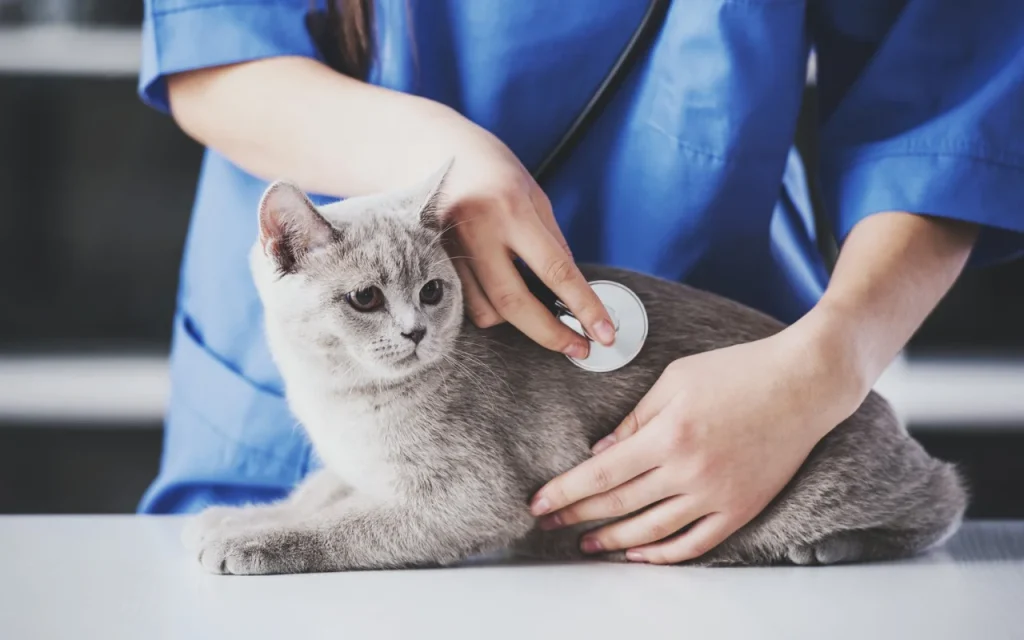
- The Real Deal (And Why It’s Top of the List): Look, if your cat is suddenly treating your duvet like a deluxe litter tray, the absolute, unskippable first thing you need to do is get them to your vet for a check-up. Before you even think about changing the litter or buying a new cat bed, you must find out if there’s a medical reason for this.
- What Your Vet Will Likely Do (From a Vet’s Perspective): We’ll want to give your cat a really good once-over and, almost certainly, get a urine sample to test. That little sample can tell us so much – if there’s an infection, any crystals (ouch!), inflammation, or other red flags. Sometimes we might need to do blood tests too. Honestly, trying to fix this with behavioral tricks before you know if your cat is actually sick is like trying to fix a leaky tap by just mopping the floor – you’re not getting to the real problem. If your cat gets the all-clear medically, then we can roll up our sleeves and look at all the other stuff.
2. Operation: Deep Clean Your Bed Like a Pro (No More “Pee Here!” Invites)
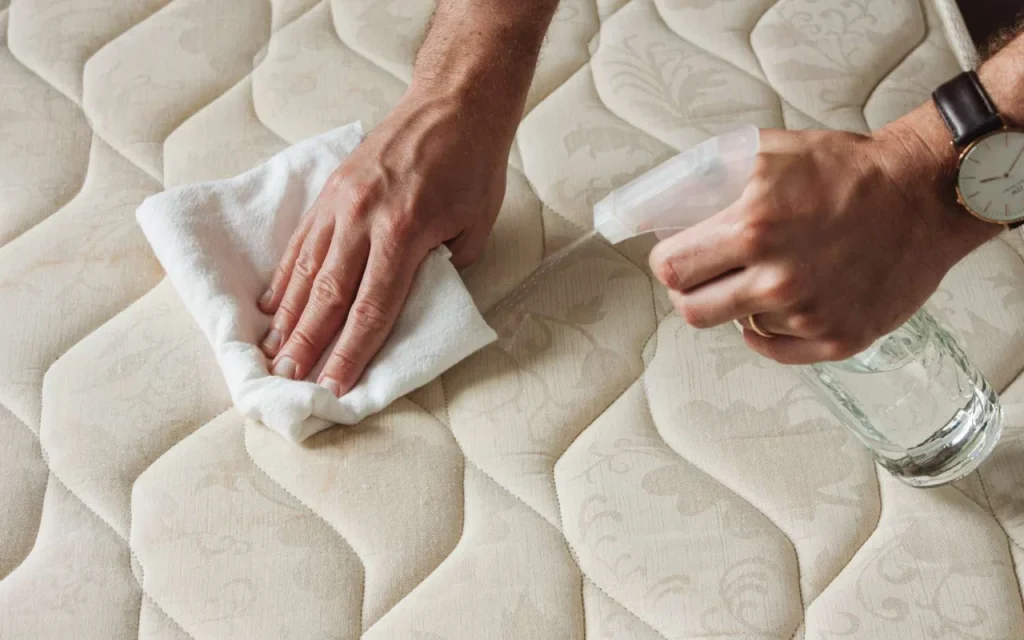
- The Real Deal: Once a cat has peed on something, their amazing sense of smell can pick up tiny leftover scent particles that basically act like a big sign saying, “This is a perfectly good toilet, feel free to use again!” And your bed, with all its comfy, absorbent layers? That can be a real challenge to get truly, deeply clean.
- How to Really Get it Clean (From a Vet’s Perspective):
- Enzyme Cleaners are Your Absolute Best Mates: Forget your usual household sprays; they often just cover up the smell for our human noses. You need a good quality enzymatic cleaner that’s specifically made to break down those stubborn pet urine proteins and completely get rid of the odor, not just hide it. Your vet clinic probably stocks a good one, or you’ll find them in pet stores.
- The Nitty-Gritty Cleaning Process: First, blot up as much of the fresh pee as you possibly can with paper towels – don’t rub, just blot. Then, you need to really soak the affected area (and a little bit around the edges, just to be safe) with that enzyme cleaner. Let it get right down into the mattress and any bedding. Make sure you follow the instructions on the bottle – some need to sit for a specific amount of time to work their magic. Then, wash all your bedding – duvet, sheets, mattress protector, everything – in hot water if the fabric can take it, using a good biological detergent. Adding a cup of white vinegar or a special pet-odor laundry product can give it an extra boost. And you might have to repeat this whole process if it was a bad one. For the mattress itself, once the enzyme cleaner has done its thing and everything is totally dry, some people swear by sprinkling it with baking soda, leaving it for a few hours, and then vacuuming it all up thoroughly.
3. Turn That Litter Box into a Feline Five-Star Spa
- The Real Deal: Sometimes the issue isn’t so much that your cat has developed a sudden passion for your bed, but more that their current litter box setup is, shall we say, less than appealing from their point of view. Cats can be incredibly particular about their bathroom standards, and frankly, who can blame them?
- How to Wow Them (From a Vet’s Perspective): It’s time to put on your “cat goggles” and see things from their level!
- The Magic Number of Boxes: The general rule of thumb that most vets will tell you is this: aim for one litter box for each cat you have, plus one extra. So, if you’ve got one cat, ideally, you should have two boxes. Two cats? Then you’re looking at three boxes. This simple thing can really help cut down on any competition or one cat “guarding” the only loo.
- Location, Location, Location (Seriously!): Are the boxes tucked away in places where your cat feels safe and secure, where they won’t be suddenly startled or feel like they can’t make a quick getaway if needed? Try to avoid putting them right next to a noisy washing machine or in a really busy bit of the hallway. And generally speaking, cats aren’t keen on having their dinner table right next to their toilet (again, can you blame them?). If the bed-peeing is the main issue, as a temporary measure while you’re working on this, try placing a litter box right there in the bedroom. It might not be your idea of perfect home décor, but believe me, it can be a hugely effective step in the right direction.
- Size Does Count! Is the box actually big enough for them? Cats generally much prefer a roomy box where they can easily get in, turn around without squashing themselves against the sides, and have a good dig. Vets often say that many of the litter boxes you buy in shops are, surprisingly, a bit on the snug side for your average adult cat. You could even consider using a large, uncovered plastic storage container as a DIY alternative – they often love the space!
- Covered or Al Fresco? Hooded boxes or open-top ones? Some cats adore the privacy of a covered box; others can feel a bit trapped in them, especially if there’s another pet in the house who might try to “ambush” them when they’re trying to go. If you’ve only ever had hooded ones, try offering an open-top version as well, or vice-versa. And this is super important, especially for older cats or those with stiff joints: make sure at least one of your boxes has a really low side that’s super easy for them to step into.
- What’s Underfoot Matters Too: Are you using a litter that your cat actually likes the feel of? So many cats, and vets see this preference all the time, really prefer a fine-grained, unscented, clumping type of litter. If you suddenly change the brand or type of litter they’re used to, that alone can be enough to make them say, “Nope, not using that!” If you do need to switch, do it really gradually, mixing a little bit of the new stuff with the old over a week or so. And please, please skip those heavily perfumed litters – a cat’s sense of smell is incredibly powerful, and strong artificial scents can be really off-putting for them!
- Keep it Spotless (Really Spotless!): Scoop out any clumps and solids at least once a day – twice a day is even better if you can manage it. And then, do a complete litter change and give the box a good scrub out with mild, unscented soap and water on a regular basis (how often will depend on the type of litter you use, but maybe aim for weekly or bi-weekly).
4. Help Your Cat See Your Bed Differently (Not as a Toilet!)
- The Real Deal: If your cat has, in their mind, started to categorize your bed as an alternative (and maybe even better, in their opinion!) potty spot, you need to do a bit of work to help them re-file it under “Comfy Nap Zone Only.”
- How to Do It (From a Vet’s Perspective):
- Make it Party Central (for Cats!): Get your cat playing some fun, interactive games on the bed. Use their absolute favorite feather wand, a laser pointer (but always, always end a laser game by letting them “catch” a physical toy so they don’t get frustrated – that’s a top vet tip!), or any other toys they go wild for.
- Treats on the Sheets!: Offer some of their most prized, high-value treats while they’re on the bed. You want them to start thinking, “Wow, being on the bed means amazing, fun, tasty things happen!”
- It’s Your Space (That Smells Like You): Spend more time just relaxing on your bed yourself – read a book, watch some TV – when your cat is around. Your presence and your familiar scent help to reinforce that it’s your special place for rest and relaxation, a shared, positive zone – and definitely, definitely not a toilet.
- Short-Term Lock-Out (If It’s Really Bad): Look, in some really persistent cases, while you’re getting all these other steps in motion, you might have to temporarily make the bedroom off-limits when you’re not in there to supervise. I know it’s not ideal, and it’s not a long-term solution, but sometimes it’s a necessary “circuit-breaker” to help stop the habit from getting even more ingrained while you’re retraining. Just make absolutely certain they have access to other really comfy resting spots and their (now hopefully totally irresistible) litter boxes somewhere else in the house.
5. Chill Them Out: Tackling Stress and Cat Anxiety
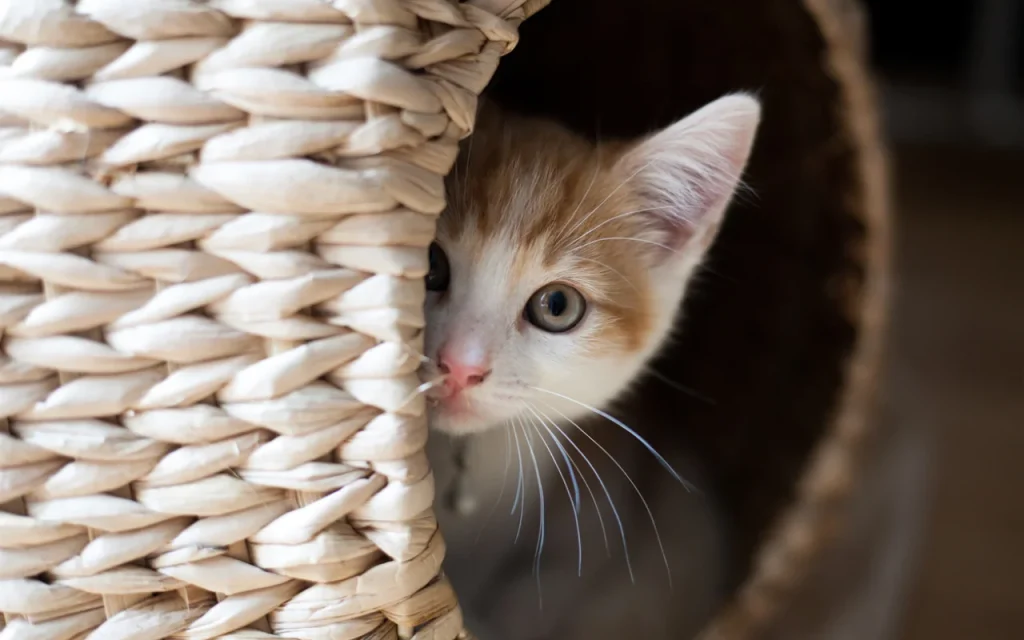
- The Real Deal: Cats are such creatures of habit, you know? And they can be incredibly sensitive – bless their little cotton socks – to any changes in their environment or daily routine. Pretty much anything new or different can dial up their stress levels, and peeing in places they shouldn’t is one of the absolute classic ways cats tell us they’re feeling anxious or unsettled.
- What Could Be Getting Their Whiskers in a Twist? (From a Vet’s Perspective):
- Try to think if anything has changed recently: Is there a new person in the house (a new baby, maybe your partner has moved in, or you’ve got a new roommate)? What about a new pet – cat, dog, or otherwise?
- Has your work schedule shifted? Have you been away on a trip (even if you had the best pet sitter in the world)? Have you even just done a big furniture rearrange? Cats notice these things!
- Is there any underlying tension or a bit of bullying going on between your cats, or maybe even between your cat and your dog?
- Could it be that your cat is just plain bored and not getting enough interesting things to do to keep their clever mind busy?
- And don’t forget the outside world! Are there strange cats parading past your windows? This can make an indoor cat feel seriously threatened and trigger them to “mark” their territory more strongly – and your bed, because it smells so much of you (their most important person!), can feel like a very significant spot to make that statement.
- Ways to Help Them Find Their Zen:
- Turn Your Home into a Cat Paradise: Make sure they have plenty of high-up places to climb and perch (cat trees are brilliant for this!), as well as some safe, cozy hiding spots where they can retreat and feel secure. And try your best to keep their daily routines – like feeding times and playtimes – as regular and predictable as possible. Cats thrive on that.
- Pheromone Magic: Products like Feliway Classic are pretty clever – they release a synthetic copy of a cat’s natural facial pheromone, which can really help create a background feeling of calm and security in their surroundings. Try plugging a diffuser in the bedroom and any other main areas where your cat likes to hang out.
- Enrich Their Day-to-Day: Make sure they get lots of good, interactive playtime with you. Puzzle feeders are also fantastic for making mealtime more of an engaging brain game. And a comfy window perch where they can safely watch the birds and squirrels go by (we call it “cat TV”!) can be a great source of entertainment.
- Keeping the Peace in a Multi-Cat Home: If you’ve got more than one cat, it’s super important to make sure there are enough key resources to go around – that means plenty of food bowls, water bowls, litter boxes, and comfy resting spots, all in different locations around the house so no one feels like they have to compete. If there’s ongoing bickering and squabbling, that’s definitely something your vet or a behavior specialist can help you work through.
- “Honestly,” a vet would likely tell you, “getting a handle on any underlying anxiety is often a massive part of solving this kind of problem. A cat who feels generally chilled out and secure is much, much less likely to start peeing outside their box because of stress.”
6. Make Your Bed a “No-Pee Zone” (At Least for Now)
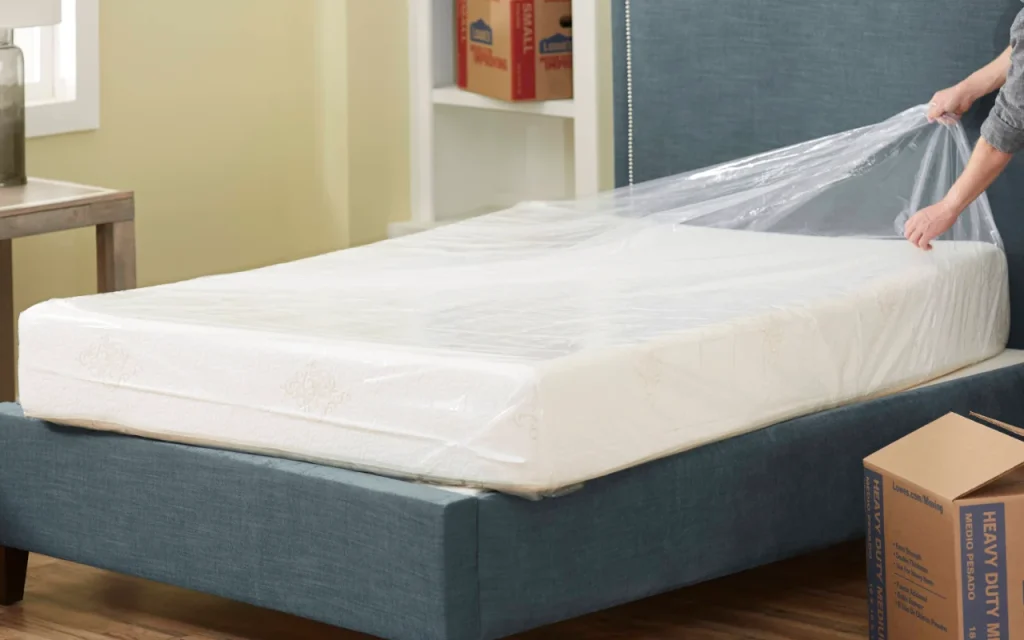
- The Real Deal: While you’re pulling out all the stops to make their litter box the most desirable toilet in the house and helping your cat see your bed as a fun, comfy place, you can also try a few tricks to make the bed surface itself a bit less inviting for an unauthorized pee break.
- How to Do It (But Be Careful & Think Temporary!):
- Change How it Feels: Cats often go for soft, absorbent surfaces when they’re peeing where they shouldn’t. You could try temporarily covering your duvet (when you’re not in bed, of course!) with something like a plastic shower curtain liner, a wipeable vinyl tablecloth, or even one of those crinkly Mylar emergency blankets. Some cats really don’t like the feel or the sound of those under their paws.
- Scent Strategies (Use With Extreme Caution!): Some cats really dislike citrus smells. You could try very, very lightly spritzing a heavily diluted citrus-scented spray onto your bedding cover (never, ever spray it directly on or near your cat!). But please, be incredibly careful with this approach. Strong smells can also be very unpleasant and even stressful for cats, which is the last thing you want. Always, always test any spray on a tiny, hidden bit of your fabric first to make sure it doesn’t stain or damage it, and ensure it’s safe for pets. And definitely avoid any harsh chemical deterrents – they’re just not worth the risk.
- A Really Important Note Here: Remember, these are just temporary management tactics, not a proper cure. The main aim is always to make their litter box the absolute best, most appealing option, not just to make your bed an unpleasant one. Otherwise, some clever (or desperate) cats will simply find another soft spot to use – like that pile of clean laundry you just folded!
7. Give Them Lots of Other Awesome Places to Lounge
- The Real Deal: Is it possible your cat is drawn to the supreme comfort and security (and your lovely, familiar scent!) of your bed because their own designated nap spots aren’t quite up to their royal standards? Or maybe they just really, really want to be close to you.
- How to Do It (From a Vet’s Perspective):
- Level Up Their Own Beds: Make sure they have several really comfy, plush cat beds dotted around in places they actually like – maybe one in a lovely sunny patch for afternoon snoozes, another tucked away in a quiet corner for when they want a bit of peace, and perhaps one in the main living area so they can be near the family.
- Your Scent Can Be Their Comfort: Try putting an old t-shirt that smells of you, or a small, soft blanket you’ve used, into their own beds. This can be a huge comfort to them, especially if they’re a bit prone to separation anxiety or just generally love being reassured by your presence.
- Warm and Cozy Does It: Particularly for older cats whose joints might be a bit achy, or if you live somewhere that gets a bit chilly, a gently warmed pet bed can feel incredibly inviting and luxurious from a cat’s perspective. They often adore them!
8. Breathe Deep, Find Your Patience, and Don’t Throw in the Towel!
- The Real Deal: Honestly, and I wish I could say otherwise, there’s very rarely a super quick, magical fix when it comes to cats peeing on the bed. It’s almost always a bit of a journey – you’ll be playing detective, trying out different approaches, tweaking things as you go, and, yes, you’ll need a good stock of patience.
- How to Keep Your Sanity (From a Vet’s Perspective):
- Maybe Keep a Few Notes: It can be surprisingly helpful to just jot down any peeing incidents – when they happened, what else was going on at the time, any little changes in your cat’s routine, and how they seem to be responding to the things you’re trying. This can really help you spot any patterns or triggers and see what’s actually making a difference (and what’s not).
- Consistency is Your Absolute Best Friend Here: Everyone in the house really needs to be on the same page with whatever plan you’re trying, especially when it comes to things like keeping those litter boxes scrupulously clean and not accidentally undoing all your hard work and patience.
- Please, Please, Please Don’t Ever Punish Them! I can’t stress this enough. Never, ever scold your cat, hit them, or (that awful, outdated myth) rub their nose in the urine. It will achieve absolutely nothing positive. It will only make them terrified of you, it will seriously damage the bond you have, and it can actually make the problem a whole lot worse by just ramping up their anxiety levels. They simply won’t understand why you’re punishing them; all they’ll learn is that you’ve suddenly become scary, and they might just get even more sneaky about where they choose to pee.
- Pat Yourself on the Back for Small Wins! If you manage to go a few days, or even a whole week, without discovering an unwanted puddle, that’s brilliant progress! Make sure you acknowledge it and keep up all the good work you’re doing.
- Knowing When to Ask for More Expert Help: If you’ve really, truly, diligently worked your way through all these steps (especially after that all-important vet check to make sure there’s nothing medical going on) and the bed-peeing is still happening after several weeks, then it’s definitely time to have another, more in-depth chat with your vet. They might suggest that it’s worth consulting with someone who’s a specialist in these things – usually a board-certified veterinary behaviorist (their qualifications might say DACVB) or a certified applied animal behaviorist (CAAB). These amazing professionals can offer even more specialized, one-on-one guidance and help you create a very tailored behavior modification plan that’s perfect for your specific cat and your particular situation.
Finding cat pee on your bed is, no two ways about it, incredibly upsetting and frustrating. But please, hang in there and remember, it really is a solvable problem most of the time. By approaching it with a good dose of understanding, a willingness to play detective, and a real commitment to your cat’s happiness and well-being, you absolutely can get your bedroom back to being a peaceful (and dry!) sanctuary. Your cat isn’t trying to be a pain or deliberately naughty; they’re asking for your help in the best way they know how. And with these vet-approved strategies, you’re now much better equipped to give them exactly that. You can do this!

